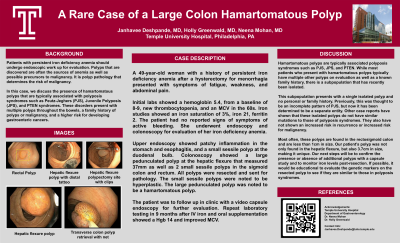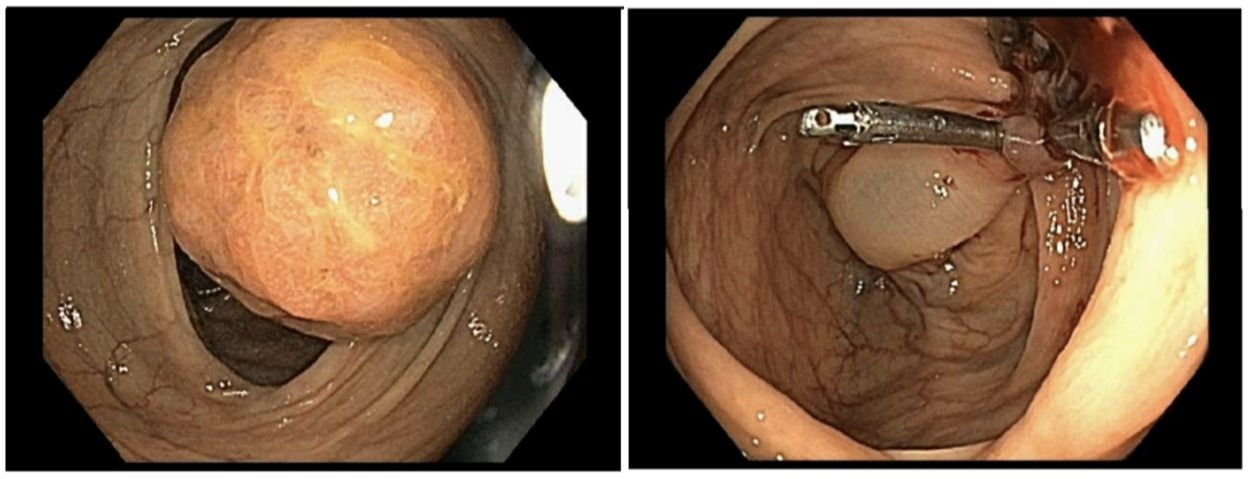Monday Poster Session
Category: Colon
P1662 - A Rare Case of a Large Colon Hamartomatous Polyp
Monday, October 23, 2023
10:30 AM - 4:15 PM PT
Location: Exhibit Hall

Has Audio
- JD
Janhavee Deshpande, MD
Temple University
Philadelphia, PA
Presenting Author(s)
Janhavee Deshpande, MD1, Holly Greenwald, MD2, Neena Mohan, MD2
1Temple University, Philadelphia, PA; 2Temple University Hospital, Philadelphia, PA
Introduction: Patients with persistent iron deficiency anemia should undergo endoscopic work up. Polyps are often discovered as sources of anemia and can be precursors to malignancy. Polyp pathology determines the risk of malignancy, which is higher in hamartomatous polyps. Previous studies show that hamartomatous polyps are typically associated with polyposis syndromes such as Peutz-Jeghers (PJS), Juvenile Polyposis (JPS), and PTEN. These disorders present with multiple polyps in the bowels, a family history, and higher risk for gastroenteric cancers. This case is unique in that it adds evidence for the existence of solitary hamartomatous polyps without an associated syndrome.
Case Description/Methods: A 49-year-old woman with persistent iron deficiency anemia after hysterectomy for menorrhagia, presented with symptoms of fatigue, weakness, and abdominal pain. Initial labs showed a Hgb 5.4 (baseline 8-9) and MCV 62. Iron studies showed: ferritin 2, iron level 21, iron saturation 3%. Upper endoscopy showed patchy inflammation in the stomach, esophagitis, and a sessile polyp at the duodenal bulb with chronic duodenitis on pathology. Colonoscopy found a 37mm pedunculated polyp at the hepatic flexure with pathology consistent with a hamartomatous polyp. 2 additional sessile polyps in the sigmoid and rectum, sized 3mm and 4mm, were hyperplastic on pathology. The patient had no known personal or family history of polyposis syndromes. Capsule study is pending. Repeat laboratory testing 9 months after resection showed a normalized Hgb and MCV.
Discussion: Hamartomatous polyps are associated with polyposis syndromes. However, recent literature has shown a subpopulation that presents with an isolated polyp and no family history. This subset was thought to be an incomplete pattern of PJS but is now considered a separate entity. Other case reports show that isolated polyps often do not have the same mutations, risk of recurrence, and increased risk for malignancy. Sporadic colonic hamartomas are a rare occurrence, most often found in the rectosigmoid and mostly described as smaller than 1cm in size. Our patient’s isolated polyp not only developed in the hepatic flexure but was also found to be 3.7cm in size. Next steps will be to confirm the presence or absence of additional polyps with a capsule study and monitor iron levels, though at this time she has had significant improvement in her iron deficiency anemia after removal of the hamartomatous polyp.

Disclosures:
Janhavee Deshpande, MD1, Holly Greenwald, MD2, Neena Mohan, MD2. P1662 - A Rare Case of a Large Colon Hamartomatous Polyp, ACG 2023 Annual Scientific Meeting Abstracts. Vancouver, BC, Canada: American College of Gastroenterology.
1Temple University, Philadelphia, PA; 2Temple University Hospital, Philadelphia, PA
Introduction: Patients with persistent iron deficiency anemia should undergo endoscopic work up. Polyps are often discovered as sources of anemia and can be precursors to malignancy. Polyp pathology determines the risk of malignancy, which is higher in hamartomatous polyps. Previous studies show that hamartomatous polyps are typically associated with polyposis syndromes such as Peutz-Jeghers (PJS), Juvenile Polyposis (JPS), and PTEN. These disorders present with multiple polyps in the bowels, a family history, and higher risk for gastroenteric cancers. This case is unique in that it adds evidence for the existence of solitary hamartomatous polyps without an associated syndrome.
Case Description/Methods: A 49-year-old woman with persistent iron deficiency anemia after hysterectomy for menorrhagia, presented with symptoms of fatigue, weakness, and abdominal pain. Initial labs showed a Hgb 5.4 (baseline 8-9) and MCV 62. Iron studies showed: ferritin 2, iron level 21, iron saturation 3%. Upper endoscopy showed patchy inflammation in the stomach, esophagitis, and a sessile polyp at the duodenal bulb with chronic duodenitis on pathology. Colonoscopy found a 37mm pedunculated polyp at the hepatic flexure with pathology consistent with a hamartomatous polyp. 2 additional sessile polyps in the sigmoid and rectum, sized 3mm and 4mm, were hyperplastic on pathology. The patient had no known personal or family history of polyposis syndromes. Capsule study is pending. Repeat laboratory testing 9 months after resection showed a normalized Hgb and MCV.
Discussion: Hamartomatous polyps are associated with polyposis syndromes. However, recent literature has shown a subpopulation that presents with an isolated polyp and no family history. This subset was thought to be an incomplete pattern of PJS but is now considered a separate entity. Other case reports show that isolated polyps often do not have the same mutations, risk of recurrence, and increased risk for malignancy. Sporadic colonic hamartomas are a rare occurrence, most often found in the rectosigmoid and mostly described as smaller than 1cm in size. Our patient’s isolated polyp not only developed in the hepatic flexure but was also found to be 3.7cm in size. Next steps will be to confirm the presence or absence of additional polyps with a capsule study and monitor iron levels, though at this time she has had significant improvement in her iron deficiency anemia after removal of the hamartomatous polyp.

Figure: Image 1: Hamartomatous polyp in the colon at the hepatic flexure before and after resection.
Disclosures:
Janhavee Deshpande indicated no relevant financial relationships.
Holly Greenwald indicated no relevant financial relationships.
Neena Mohan indicated no relevant financial relationships.
Janhavee Deshpande, MD1, Holly Greenwald, MD2, Neena Mohan, MD2. P1662 - A Rare Case of a Large Colon Hamartomatous Polyp, ACG 2023 Annual Scientific Meeting Abstracts. Vancouver, BC, Canada: American College of Gastroenterology.
